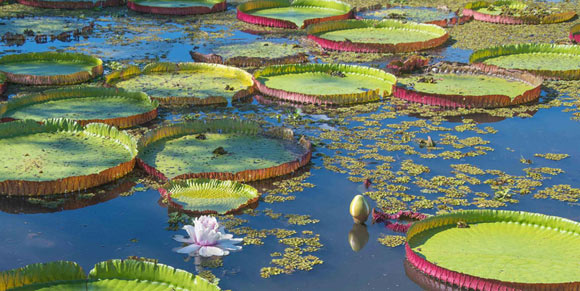Victoria boliviana marks the first discovery of a giant waterlily species in over a century and breaks the record as the largest in the world.
Victoria is a small genus of flowering plants with very large green leaves in the waterlily family Nymphaeaceae.
Named after the British monarch Queen Victoria in 1852, it occurs in white-water and occasionally black-water leas and igapos of the Amazonian and Paraná river basins in the South America.
Victoria flower buds develop underwater and emerge above the surface when ready to bloom. Each flower opens over two consecutive nights, changing form and color dramatically in-between.
These form and color changes reflect their role in pollination, which is to trap pollinating beetles.
“Species in the genus Victoria have been poorly characterized for decades,” said Dr. Alex Monro of the Royal Botanic Gardens, Kew, and his colleagues.
“The knowledge gap stems from an absence of type specimens in global plant collections. This is mainly due to the fact that giant waterlilies are difficult to collect in the wild.”
“With the goal of improving knowledge of Victoria, we compiled all existing information from historical records, horticulture and geography, and assembled a dataset of the species’ characteristics using citizen science and specimens from herbaria and living collections around the world.”
Named Victoria boliviana, the newly-described species occurs only in the flood plains of the Llanos de Moxos in Bolivia.
With flowers that turn from white to pink and bearing spiny petioles, it is now the largest waterlily in the world, with leaves growing as wide as 3 m (9.8 feet) in the wild.
“The current record for the largest species is held by La Rinconada Gardens in Bolivia where leaves reached 3.2 m (10.5 feet),” the researchers noted.
They also analyzed DNA of Victoria boliviana and found it was genetically very different from the other two members of its genus, Victoria amazonica and Victoria cruziana.
Their results suggest that the new species is most closely related to Victoria cruziana, and that they diverged around a million years ago.
“In the face of a fast rate of biodiversity loss, describing new species is a task of fundamental importance,” said Dr. Natalia Przelomska from the Royal Botanic Gardens, Kew, and the Smithsonian Institution’s National Museum of Natural History.
“We hope that our multidisciplinary framework might inspire other researchers who are seeking approaches to rapidly and robustly identify new species.”
“Having these new data for Victoria and identifying a new species in the genus is an incredible achievement in botany — properly identifying and documenting plant diversity is crucial to protecting it and sustainably benefiting from it,” Dr. Monro said.
The team’s paper appears in the journal Frontiers in Plant Science.
_____
Lucy T. Smith et al. Revised Species Delimitation in the Giant Water Lily Genus Victoria (Nymphaeaceae) Confirms a New Species and Has Implications for Its Conservation. Front. Plant Sci, published online July 4, 2022; doi: 10.3389/fpls.2022.883151








